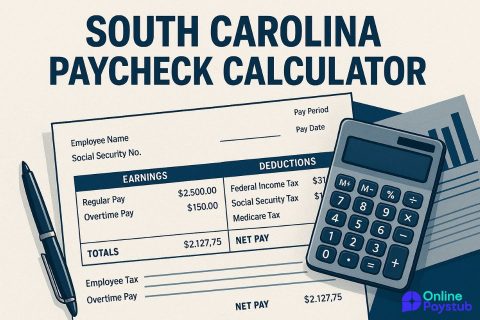Understanding how your take-home pay is calculated in Ohio requires analyzing several interrelated components, from federal withholdings to local taxes and individual deductions. Each of these factors plays a specific role in shaping the final net amount you receive on payday.
What Factors Determine Your Take-Home Pay in Ohio?
All Ohio workers are subject to federal tax obligations, including income tax, Social Security (6.2%), and Medicare (1.45%). These deductions are applied regardless of state residence and represent the foundation of every paycheck calculation. Incomes exceeding $200,000 (or $250,000 for joint filers) incur an additional 0.9% Medicare surtax. These federal deductions are non-negotiable and form the largest portion of reductions before state-level taxes even come into play.
Ohio State Income Tax Structure
Ohio applies a progressive income tax system with three brackets. As of 2024, income under $26,050 is not taxed, income between $26,050 and $100,000 is taxed at 2.75%, and income exceeding $100,000 is taxed at 3.50%. Unlike some states, Ohio’s brackets are not adjusted for filing status. This means whether you’re single or married, the same tax rates apply. The structured bracket system ensures a proportional contribution from all income levels.
Local and Municipal Income Taxes in Ohio
In addition to state taxes, more than 400 municipalities in Ohio impose their own income taxes, commonly known as RITA taxes. These local rates can range from 0.5% to 3%, depending on your work and residence locations. Unlike state taxes, local taxes can vary widely and are often overlooked. For employees working in one city and living in another, tax credits may apply, but calculations become more complex and often require guidance or precise paycheck tools.
How Do Pre-Tax and Post-Tax Deductions Affect Your Paycheck?
Beyond federal, state, and local taxes, another critical influence on net income in Ohio is how deductions are structured. These deductions fall into two primary categories: pre-tax and post-tax. Each type alters your taxable income differently, and understanding their mechanics is essential for effective financial planning.
Common Pre-Tax Contributions in Ohio Payrolls
Pre-tax deductions reduce your taxable income before any tax is applied. In Ohio, these typically include contributions to retirement accounts like 401(k) and 403(b), health savings accounts (HSA), flexible spending accounts (FSA), and employer-sponsored health insurance premiums. For example, an employee contributing $300 monthly to a traditional 401(k) lowers their state, local, and federal taxable income by the same amount.
In practice, this means that even if your gross pay remains constant, your net pay can be optimized through thoughtful use of pre-tax options. Additionally, since Ohio does not exempt Roth retirement contributions from income tax, the choice between traditional and Roth accounts directly affects current paycheck outcomes.
Examples of Post-Tax Deductions
Post-tax deductions are subtracted after taxes have already been calculated. These often include Roth IRA or Roth 401(k) contributions, union dues, charitable donations via payroll, and certain life or disability insurance premiums. While they do not reduce current taxable income, post-tax deductions may still be valuable for long-term financial goals.
In Ohio payroll systems, clear visibility of both deduction types is critical for reading pay stubs accurately. Many online paycheck calculators allow you to enter these figures separately, offering a clearer estimate of your final take-home amount. If ignored, these deductions can cause unexpected discrepancies between gross and net pay, especially for employees with multiple voluntary benefits.
How to Use an Ohio Paycheck Calculator Effectively?
Accurate paycheck estimation starts with knowing how to use the available tools correctly. Ohio paycheck calculators are designed to simulate real-world payroll processes, incorporating federal, state, local taxes, and personal deductions. But these tools are only as accurate as the data you provide.
Step-by-Step Input Guide for Hourly vs. Salary Workers
Whether you’re paid hourly or on a salary, the process begins with defining your gross pay. For hourly workers, multiply your hourly rate by total hours worked per pay period. For salaried workers, divide your annual salary by the number of pay periods commonly 24 for semi-monthly or 26 for bi-weekly schedules.
Once your gross pay is entered, select your pay frequency and enter your filing status (single, married, head of household). Then, detail your withholdings using Ohio’s equivalent of the W-4 form, known as Form IT 4. Don’t forget to account for dependents, multiple job situations, and any additional income that might affect your tax liability.
The final critical step is entering your deductions both pre-tax and post-tax. Reliable calculators will separate these for clarity. Including items like 401(k) contributions, HSA plans, or even voluntary dental insurance helps produce a far more realistic take-home estimate.
Accuracy and Limitations of Online Calculators
While Ohio paycheck calculators provide a strong baseline, they are not replacements for full payroll software or licensed tax advice. One limitation is how bonuses, commissions, or unique deductions are handled they may be simplified or excluded altogether. Some tools do not incorporate every municipal tax or school district code, which can skew results, especially for workers living in complex tax jurisdictions like Cleveland Heights or Upper Arlington.
To increase reliability, always cross-reference your pay stub with your calculator results. If significant differences arise, review your entries or consult an HR/payroll professional. When used properly, these calculators become a practical way to forecast changes whether adjusting your W-4, comparing job offers, or planning for retirement savings.
How Are Bonuses and Commissions Calculated in Ohio Payroll?
Bonuses and commissions are treated differently from base salary or hourly wages, particularly when it comes to tax withholding in Ohio. These forms of supplemental income can have a distinct impact on your take-home pay, depending on how they’re paid out and reported.
Flat Rate Withholding on Supplemental Wages
In Ohio, most employers apply a flat withholding rate to supplemental wages. For the 2024 tax year, the state rate for bonuses and commissions is 3.5%. This approach simplifies calculations but can result in over- or under-withholding depending on your overall tax bracket. At the federal level, the IRS allows two methods: aggregate and flat-rate. The flat federal rate is 22%, and when combined with state and local taxes, the total withholding can exceed 30% of your bonus or commission.
Employees receiving irregular supplemental pay should not assume their net pay will be consistent with base earnings. A bonus that appears generous in gross terms might shrink significantly after these higher rates are applied.
Integration into Regular Payroll or Issued Separately
How your employer processes these payments also matters. If the bonus or commission is bundled with your regular paycheck, it may be taxed according to your existing withholding profile. If it’s issued as a separate check, flat rate rules will apply automatically. This can create noticeable differences in net pay, even if the gross bonus amount remains the same.
Some paycheck calculators offer advanced input options for supplemental income, allowing users to specify whether it is paid separately or combined with salary. This flexibility is essential for professionals who rely on performance-based compensation or commission-heavy roles.
How Do School District Taxes Influence Your Ohio Paycheck?
School district income taxes are a unique component of Ohio’s payroll landscape. Unlike many states, Ohio allows certain local school districts to levy income taxes in addition to municipal and state-level taxes. These taxes are collected directly through payroll withholding and can noticeably reduce your net pay depending on where you live.
Which School Districts Impose Taxes?
As of recent tax years, more than 200 school districts across Ohio collect income taxes. These taxes apply based on your home address, not your work location. They can be levied either as a percentage of your Ohio taxable income or on your earned income only, depending on how the district has structured its tax base.
For example, someone living in the Indian Hill Exempted Village School District may be subject to a tax rate over 1%, even if their employer is located in a non-taxing jurisdiction. This means your withholding will reflect this additional liability whether or not your paycheck calculator accounts for it, which is why using a calculator with district-level granularity is important.
How Are These Taxes Calculated and Reported?
The school district tax is typically withheld by your employer once you’ve declared your district code using the Ohio Form IT 4 SD. If you’re unsure of your school district, the Ohio Department of Taxation offers a lookup tool based on your address. Misreporting your district or failing to file can result in penalties, so accuracy is essential.
On your pay stub, the school district tax may be listed separately or included in a broader local tax category, depending on the payroll provider. Calculators that allow manual input of district tax rates offer the most precise estimate of take-home pay. If you live in a taxing school district and don’t see the expected deductions on your paycheck, it’s worth verifying your withholding setup with your employer or payroll administrator.




No comments to show.